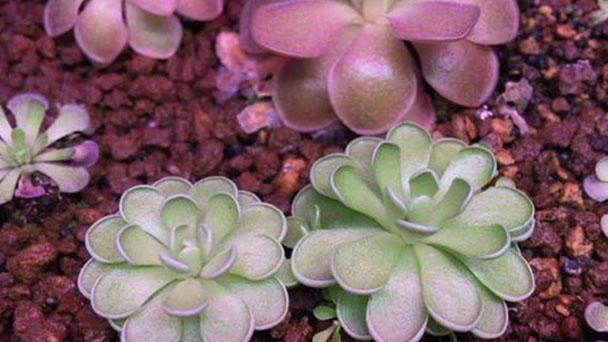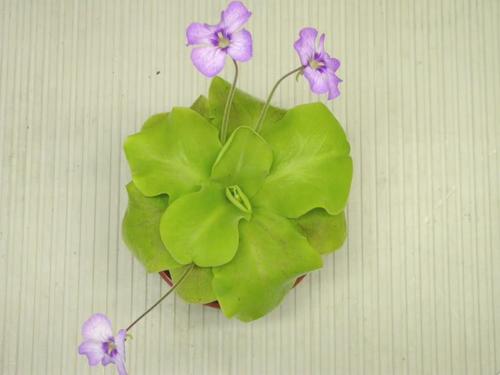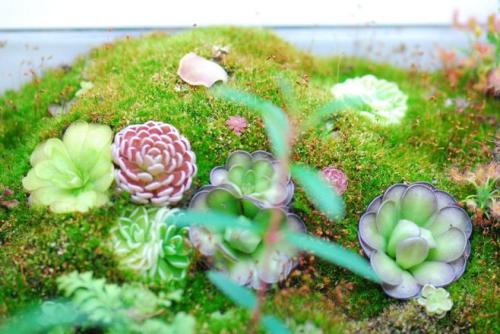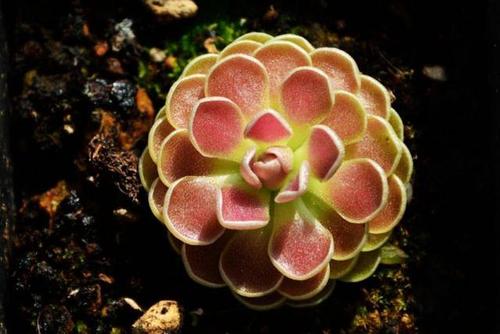Pinguicula alpina (alpine butterwort) profile
Written by Maggie
Mar 18 2021

Pinguicula alpina (alpine butterwort) belongs to the bladderwort family. Pinguicula alpina is a perennial herb. The leaves are long and oval, and may be called simply Pinguicula alpina. It is a mucinous insectivorous plant. There are about 130 species in all genera except Australia, of which more than 30 are subspecies, varieties or variants.
Pinguicula alpina is a popular insectivorous plant with delicate lines, transparent leaves and deadly flowers. It is also widely cultivated in horticulture.
Pinguicula alpina picture

Morphological characteristics of Pinguicula alpina
Pinguicula alpina is a perennial herb. Root majority, coarse 0.4-1 mm.
Leaf
Pinguicula alpina has 3-13 leaves, basal rosette, crisp succulent, membranous when dry; Leaf blade is elliptic, 1-4.5 cm long, 0.5-1.7 cm wide, margin entire and encoiled, apically obtuse or rounded, base broadly cuneate, descending into short stalks, above densely covered with many mucinous glandular hairs, abaxially glabrous, both surfaces pale green, lateral veins 5-7 on each side.
Flowers
The flowers of pinguicula alpina are solitary. Pinguicula alpina has 1-5 pedicels, 2.5 -- 13 cm long, 0.4 -- 1.2 mm thick, distally thickening at fruition, glabrous.
Calyx is 2-lobed, glabrous; Upper lip is 3-lobed, lobes ovoid, florescence 2 -- 3 mm long, fruity 2 -- 4 mm long, lower lip 2 -- lobed, ovate, fluorescence 1 -- 1.5 mm long, fruity 1 -- 2.5 mm long.
Corolla of Pinguicula alpina is 9 -- 20 mm long, white, spur pale yellow; Upper lip is 2-lobed to middle, lobes broadly ovate to suborbicular, 2 -- 4.5 mm long and 2 -- 4.5 mm wide, lower lip 3-lobed, middle lobes larger, rounded or broadly obovate, apical lobes rounded or truncate, 3 -- 8 mm long and 4 -- 8 mm wide, lateral lobes broadly ovate, 1.5 -- 5 mm long and 2 -- 6 mm wide; Tube is funnelform, 3-7 mm long, mouth 5-10 mm in diameter, glabrous outside, white pubescent inside mask; Spur of Pinguicula alpina is terete, 3-6 mm long, 2-2.5 mm thick at the middle, rounded at the apex.
Stamens of Pinguicula alpina are glabrous; Filaments linear, curved, 1.4-1.6 mm long; The apical confluence of the chamber. Pistil is glabrous; Ovary is globose, ca. 1.5 mm in diam. Style is very short; Stigma is lower lip rounded, ca. 1.8 -- 2 mm wide, margin fimbriate, upper lip minute, narrowly triangular.
Fruit
Capsule of Pinguicula alpina is ovoid to ellipsoid, 5 -- 7 mm long and 2.5 -- 5 mm wide, glabrous, loculically dehiscent. Seeds many, long elliptic, 0.6-0.8 mm long, seed coat glabrous, with reticulate protruding, grid lengthened longitudinally.
Ecological habits of Pinguicula Alpina
Pinguicula alpina has a wide distribution, covering two tropical temperate climate zones, and its growth habits vary greatly in different climate zones.
Pinguicula alpina is found between damp rock walls and under alpine rhododendron bushes at an altitude of 2300-4500 m.
How to grow and care for Pinguicula alpina
Temperature, light and humidity
Temperate Pinguicula alpina grows mostly in high latitudes and cold areas, and its survival temperature is generally between -10-30 ° C with the best temperature between 10-20 ° C. Pinguicula alpina is a kind of insectivorous plant that is most heat-resistant, and it is difficult to grow in summer without cooling equipment. The substrate should be kept slightly dry in winter, when it can survive -10 C temperatures as dormant buds. Most species also develop "winter shoots" at the base of dormant buds, which will germinate into new plants the following spring, but they are very fragile and should be transplanted with care.
Tropical Pinguicula alpina is not as cold-resistant as temperate Pinguicula alpina, with survival temperatures ranging from 0 to 32 ° C and optimum temperatures ranging from 15 to 25 ° C. It is higher than temperate Pinguicula alpina, but it is still relatively heat resistant. Tropical non-dormant populations are not dormant, very little throughout the year, and all prey on insects .Tropical dormant populations grow succulent leaves without mucus in winter and need to keep the substrate drier during hibernation.
Pinguicula alpina can be grown with highland pitcher plants and sun bottle plants. It is best not to receive direct sunlight (especially hot noon), but still need bright scattered light, such as a ventilated balcony or window sill, which can be placed in a room with cool air is best.
Pinguicula alpina is also sensitive to humidity, which can affect its growth if the humidity is below 40% for several days. When this happens, it is usually sufficient to be placed indoors (remember to provide bright scattered light).
The substrate
Pinguicula Alpina prefers a loose, airy, dry substrate with a neutral pH value. A 1:1:1 mixture of peat, perlite and vermiculite can be used. Vermiculite is slightly alkaline, which reduces the acidity of the peat and improves the pH value of the substrate. Pinguicula alpina from Mexico also grows mostly in alkaline soils and can be added with 10% to 20% chalk and gypsum particles to increase the pH of the substrate. The Mexican Pinguicula alpina actually grows well in neutral soils, but may grow in slightly alkaline soils simply to increase the competitiveness of the population.
Watering
Pinguicula alpina prefers a water-draining, permeable substrate, and the small size of the pot allows the substrate to dry quickly, but they are intolerant.In order to avoid frequent watering, you can use the method of "waste water" for water supply, the flowerpot is placed in the water tray, glass tank and other containers, so that the water permeates to the whole flowerpot, only to keep the water tray has about 1 cm of water, you can make the matrix to keep wet.
If the base water is too wet and will rot the leaves of the Pinguicula alpina, add a layer of ceramsite or perlite particles to the bottom of the basin. The height of the particles should be more than 2 cm above the water surface and allow the water to penetrate slowly so that the base water will not be too wet but will remain dry. If you do not want to replace the pot, you can also place particles such as perlite in the water and above the water, and then put the pot over the perlite, so that the matrix in the pot does not contact the water directly.
Pinguicula alpina has a high requirement for water, which requires soft water with low mineral content. Using hard water with high hardness for a long time will cause its leaves to rot.If the local tap water quality hardness is high, should try to use rainwater, barreled water, pure water, air conditioning condensate, pure water machine water with reverse osmosis function (RO water) and other soft water.

Disease control of Pinguicula alpina
Pinguicula alpina is generally free of pests and diseases, but caution is required.
Insect pests
Pinguicula alpina is basically free from pests. It should be noted that when there is no food to eat, green insects, ground worms and other pests may gnash on the leaves of Pinguicula alpina. If there are gnawed traces on the leaves, it is necessary to find out whether there are such pests near the plant in time and catch and kill them. Pinguicula alpina is sensitive to fertilizers, pesticides, fungicides and other substances and should be avoided.
Fungal infection
Fungal infection is a common problem in Pinguicula alpina. It usually occurs when it is closed, not ventilated and at high temperatures. A well-ventilated environment should be provided and regular ventilation should be carried out when it is kept closed. If the fungus has begun to develop on the substrate or plant, it is necessary to immediately strengthen ventilation to remove the diseased parts.
The distribution area of Pinguicula Alpina
Population
According to the distribution and habits of its native place, it can be roughly divided into the following three groups:
1. Tropical non-dormant populations: Most of Pinguicula alpina grow in tropical and subtropical regions, and there are about 17 species.They vary little throughout the year and all have trapping leaves that generally bloom at least in spring and autumn, such as the giant Pinguicula alpina and the yellow-flowered Pinguicula alpina. A few grow in temperate regions, such as the ice crystal Pinguicula alpina.
2. Tropical dormant populations: Most of them Pinguicula alpina in tropical or subtropical regions, with about 51 species. The trap leaves begin to grow in the spring, wilt in the cool late fall, and grow fleshy, compact, non-trap leaves through the winter, until the trap leaves continue to grow in the warm spring. They generally bloom at least in spring and autumn, such as the American Pinguicula alpina and the limestone Pinguicula alpina.
3. Temperate population: There are about 34 species that grow in temperate or frigid regions, where the climate is relatively cold. Insect-catching leaves begin to grow in the spring and stop growing in the late fall, usually the roots and large leaves wither, and in their rosette-like centers grow a droplet of dormant buds, which pass through the cold winter and germinate when the spring warms up. Most of these species, such as Pinguicula alpina, develop small winter buds at the base of their dormant buds, which grow into new plants in the spring.They all grow in temperate or frigid regions.
In addition, Pinguicula alpina from Mexico is often divided into a large group in horticulture. There are about 42 species in total, all of which are tropical species.
Natively
Pinguicula alpina is found in temperate regions of the Northern Hemisphere and alpine regions of Central and South America. More than 50% of the species can be found in Central America, mainly Mexico. The mountain Pinguicula alpina is the most widely distributed and can be found in almost all European countries, Russia, Canada, the United States and even cold Iceland. It is also found in Shanxi, Sichuan, Guizhou, Yunnan and southern Tibet in China. Pinguicula alpina is born on the damp rock walls or on the wetlands under the shrubs of the mountains at an altitude of 2300-4500 meters.
Pinguicula alpina is not drought-tolerant and mostly grows on the wet rock walls of mountains, some grows in wetlands and swamps, and a few grow on other trees together with moss. Pinguicula alpina's native land is mostly underlit and grows on poor soil where other grasses struggle to grow, thus preventing the plant from being "overwhelmed" by other plants. Mexican Pinguicula alpina generally grows in poor and slightly alkaline soils, but it also grows well in neutral soils. Some species, such as the wild Pinguicula alpina, the high-crested Pinguicula alpina and the Portuguese Pinguicula alpina, can grow in more acidic bog peatlands. Species such as Casabutto Mountain Pinguicula Alpina, Semi-epiphytic Pinguicula Alpina, and Pinguicula Alpina are attached to the trunk.
Pinguicula Alpina method of trapping the pansy
Pinguicula Alpina Active Fly Paper Trapping. Glands on the leaves secrete special odors that attract insects and make them stick to the mucus on the leaves. In some species, the central rolls around the edges of the leaves surround the insects. Glands on the leaves secrete digestive juices to digest the insects.

Latest Updated
- Benefits of Bugleweed - 7 Science-backed Health Benefits
- Bugleweed Dangers & Side Effects - Is It Poisonous?
- How to Plant Evergreen Trees - What You Should Know
- When to Plant Evergreens - Grow Guide for Evergreen Trees
- 12 Wonderful Evergreen Shrubs for Your Garden
- 12 Popular Evergreen Plants with Pictures for Beginners
- When And How To Prune A Lilac Bush Like a Pro
- How to Grow & Care for Lilac Vine (Hardenbergia Violacea)
- Japanese Lilac Tree (Syringa Reticulata) Care & Propagation Guide
- Shumard Oak Pros and Cons - What to Know
Popular Articles
- Winter maintenance of Antirrhinum Majus
- How to Grow Terminalia Mantaly Tree
- How to Grow and Care for Crossostephium Chinense
- How to grow Antirrhinum Majus in spring
- Peristeria Elata (Dove Orchid) Profile: Info & Care Guide
- Underwatered Snake Plant (Sansevieria Trifasciata) - Signs And How To Fix
- How to Care for Brazilian Jasmine Plant (Mandevilla Sanderi)
- How to Grow & Care for Graptopetalum Purple Delight in Summer
- Rosa Chinensis (China Rose): Plant Growing & Care Tips
- How to Care for Baby Sun Rose (Aptenia Cordifolia)